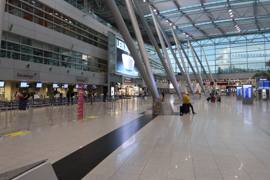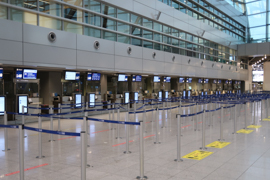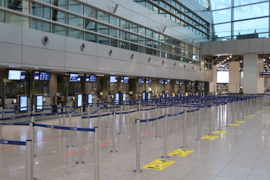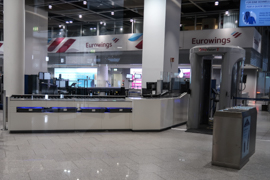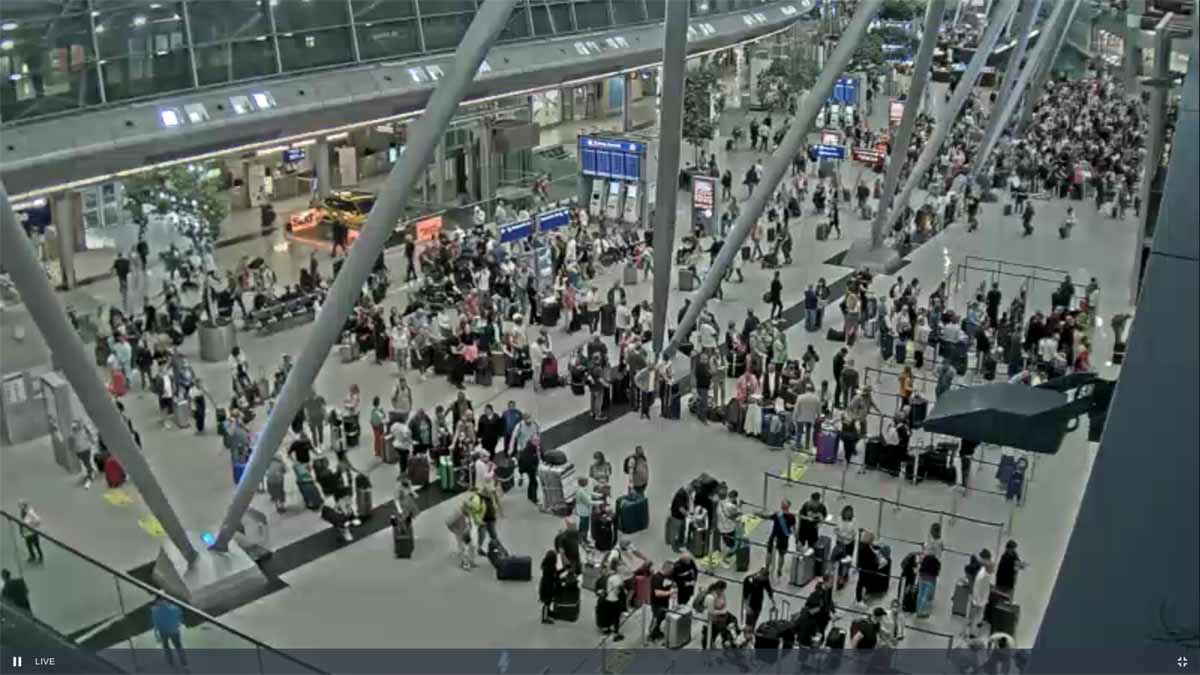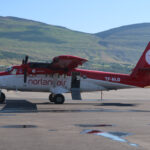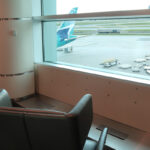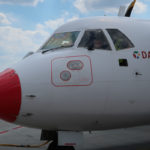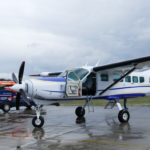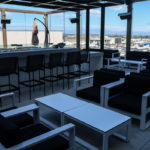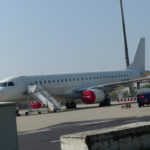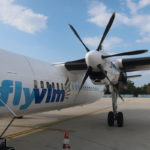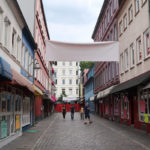Early summer 2022. After the Covid-19 crisis feels to have come to a certain end, air travelers all over Europe need to stay strong: newspapers report about handling issues in practically all major European airports. German newspapers complain about long queues and baggage handling times, Dutch passengers even alter to German airports, as Amsterdam-Schiphol (AMS) is even worse and people typically wait outside(!) the terminal building as the queues are too long. I just wanted to see what is going on and do my own analysis.
Dusseldorf Airport (DUS) has a beautiful tool, which allows me to watch a typical morning at the airport without being there by myself: they have public webcams, one overlooking the landside area of the A Gates area.Another advantage of Dusseldorf (DUS) to me is that it is my most frequently flown airport, so that I know the facilities very well. I have some background in analyzing traffic systems in regards of their robustness against delays and in modeling waiting lines. Nonetheless, this blog is not scientific and might also have some mistakes. I just did screenshots so that you cannot reconcile the walking routes of individual passengers. In general, I feel that the quality is not good enough to identify persons. The post is based on the morning of 16th June 2022, a Thursday morning, which was a public holiday in this part of Germany.
With this posting, I am not trying to “bash” Dusseldorf Airport (DUS). The analysis would be similar at many European airports in this time. The tools, esp. the webcam, just make it handier for me to chose this travel hub.
The Post-Covid Situation at European Airports
There are a lot of very bad, but also some very good sum-ups, why Covid-19 lead to a mess in the 2022 aviation world. To make the long story short, there were two factors: the airports and airport service providers fired many employees during the low flight volume pandemic. After traveling goes back to normal, they did not make people going back to their jobs or acquire new ones. Depending on the job, you need a certain time for training before you are fit for work as well. The second effect is that people longed much more for traveling again than some companies might have expected. The demand almost exploded, booking figures for holiday destinations are back to 2019 level. Too low capacity, too high demand… You know the result.
A much better – and more detailed – analysis, including the view of flight crew and pilots, can be found in this excellent video:
Dusseldorf Airport – A Gate Area Overview
Especially for those of you, I give you a little overview below, what you see on the pictures. The most interesting areas are the top right of the webcam, where you see the Eurowings check-In for all flights. The Hurghada flight (see schedule below) has a designated check-in area. Correndon is splitting their check-in by flight on the bottom right side. The waiting line for the Security, A Gates, is rather in the middle of the left hand side of the webcam. You have to say that the significantly larger part of the line for the security control is out of sight of the webcam.

Here are some more views, I took of this part of the airport on other days (in the late evening hours when there was less operation). The first snaps are taken from the rather large Eurowings area. The next pictures are illustrating the check-in area used by Iberia, Correndon, the three major Lufthansa carriers and the Hurghada flight on the illustration above. These places are also in the rear of the picture with the golden (car rental) advertisement car, which is a good orientation on the Dusseldorf webcam.









Finally, here are some impressions of the entrance to the Security Gates A. I feel that even the rather small picture format illustrates the vast capacity of “storing” people in this area in addition to queues you will see in the screenshots below.



In contrast to the typical way Flyctory.com is set up, you may click on the major size webcam pictures to enlarge them for more detail.
Dusseldorf Airport at 16th June – Flight Schedule
One thing I feel is very neglected in many specific local analysis is the flight schedule. I will look into the time between 3:00 and roughly 6:00 hrs local time. Dusseldorf Airport is not allowed to operate in night hours, the first planes in fact take off at 6:00 hrs. As people are told to be at the airport three hours in advance, here is the flight schedule of that day between 5:50 (off block time, so that they have ten minutes for departure) and 9:00 hrs: You have to clearly state that this is a rather moderate schedule for summer season in Dusseldorf – especially during summer school holidays, the airport is running at an even higher frequency.
| Time |
Flight |
Number |
Destination |
Aircraft |
| 5:50 |
DE |
1152 |
Split (SPU) |
75T |
| 5:50 |
X3 |
2312 |
Palma de Mallorca (PMI) |
73H |
| 5:50 |
DE |
1514 |
Palma de Mallorca (PMI) |
75T |
| 5:50 |
DE |
1774 |
Palma de Mallorca (PMI) |
320 |
| 5:50 |
DE |
1756 |
Samos (SMI) |
320 |
| 6:00 |
LH |
73 |
Frankfurt (FRA) |
319 |
| 6:00 |
X3 |
2404 |
Mahon / Menorca (MAH) |
73H |
| 6:00 |
X3 |
2914 |
Ibiza (IBZ) |
73H |
| 6:00 |
X3 |
4588 |
Rhodes (RHO) |
73H |
| 6:00 |
DE |
1622 |
Rhodes (RHO) |
32B |
| 6:05 |
EW |
9584 |
Palma de Mallorca (PMI) |
32N |
| 6:10 |
SK |
620 |
Copenhagen (CPH) |
CR9 |
| 6:10 |
EW |
9536 |
Malaga (AGP) |
32A |
| 6:10 |
DE |
1620 |
Kos (KGS) |
32B |
| 6:20 |
KL |
1852 |
Amsterdam (AMS) |
E90 |
| 6:20 |
EW |
9048 |
Berlin (BER) |
319 |
| 6:20 |
EW |
9612 |
Korfu (CFU) |
320 |
| 6:20 |
DE |
1780 |
Preveza (PVK) |
32B |
| 6:20 |
DE |
1146 |
Zakynthos (ZTH) |
320 |
| 6:30 |
EW |
4840 |
Palma de Mallorca (PMI) |
320 |
| 6:35 |
EW |
4239 |
Prague (PRG) |
319 |
| 6:35 |
EW |
9654 |
Thessaloniki (SKG) |
320 |
| 6:35 |
EW |
9630 |
Rhodes (RHO) |
32A |
| 6:40 |
BA |
3270 |
London-City (LCY) |
E90 |
| 6:40 |
AF |
1107 |
Paris (CDG) |
E90 |
| 6:40 |
EW |
9340 |
Manchester (MAN) |
320 |
| 6:50 |
EW |
9762 |
Zurich (ZRH) |
223 |
| 6:50 |
EW |
9826 |
Milan (MXP) |
32A |
| 6:50 |
EW |
9468 |
London (LHR) |
223 |
| 6:50 |
EW |
9784 |
Budapest (BUD) |
32A |
| 6:50 |
EW |
9680 |
Athens (ATH) |
320 |
| 6:55 |
EW |
9742 |
Geneva (GVA) |
319 |
| 7:00 |
EW |
9082 |
Munich (MUC) |
319 |
| 7:00 |
EW |
9336 |
Birmingham (BHX) |
223 |
| 7:00 |
XR |
4040 |
Korfu (CFU) |
738 |
| 7:05 |
EW |
9814 |
Catania (CTA) |
319 |
| 7:10 |
EW |
9810 |
Venice (VCE) |
223 |
| 7:10 |
EW |
9754 |
Vienna (VIE) |
223 |
| 7:10 |
EW |
9868 |
Cagliari (CAG) |
319 |
| 7:10 |
X3 |
2322 |
Palma de Mallorca (PMI) |
73H |
| 7:10 |
EW |
9530 |
Alicante (ALC) |
320 |
| 7:10 |
EW |
5112 |
Hurghada (HRG) |
32A |
| 7:15 |
XR |
4044 |
Tenerife South (TFS) |
738 |
| 7:20 |
BA |
935 |
London (LHR) |
319 |
| 7:20 |
LO |
406 |
Warsaw (WAW) |
E75 |
| 7:20 |
EW |
9216 |
Stockholm (ARN) |
319 |
| 7:25 |
LH |
2035 |
Munich (MUC) |
319 |
| 7:30 |
EW |
9242 |
Copenhagen (CPH) |
319 |
| 7:30 |
TK |
1530 |
Istanbul (IST) |
321 |
| 7:30 |
XQ |
185 |
Antalya (AYT) |
73H |
| 7:50 |
EW |
9882 |
Rome (FCO) |
320 |
| 7:50 |
IB |
3137 |
Madrid (MAD) |
32A |
| 7:55 |
EW |
9578 |
Palma de Mallorca (PMI) |
32A |
| 8:00 |
PC |
1006 |
Istanbul S-G (SAW) |
738 |
| 8:05 |
XQ |
181 |
Antalya (AYT) |
7M8 |
| 8:05 |
XQ |
749 |
Gaziantep (GZT) |
73H |
| 8:15 |
KL |
1854 |
Amsterdam (AMS) |
E75 |
| 8:25 |
EW |
4335 |
Salzburg (SZG) |
319 |
| 8:25 |
XQ |
281 |
Antalya (AYT) |
73H |
| 8:35 |
LH |
79 |
Frankfurt (FRA) |
E90 |
| 8:35 |
EW |
7061 |
Hamburg (HAM) |
32A |
| 8:40 |
TK |
4317 |
Antalya (AYT) |
73H |
| 9:05 |
AF |
1307 |
Pairs (CDG) |
E90 |
| 9:05 |
DE |
1848 |
Palma de Mallorca (PMI) |
75T |
| 9:05 |
XQ |
685 |
Dalaman (DLM) |
73H |
The exact destinations don’t matter to much, it is rather about the size of the planes (i.e. the number of passengers) and which gates they are using. In Dusseldorf, you may use any security for any gates, but this is rarely known by passengers (and also rarely promoted by the staff). C Gates are for non-Schengen flights. A Gates are typically used by Lufthansa, Eurowings and Star Alliance, there were a few Condor A Gates flights that day as well, but you can roughly say that most Schengen holiday flights (e.g. Spain, Italy, Greece), if not operated by Eurowings are using B Gates.
I feel the high load of planes scheduled to depart / go off-block (i.e. leave the gate/parking position) between 05:50 and 06:20 hrs is questionable, especially if you are running under capacity constraints. Of course, the earlier planes leave, the more rotations / flights they can do that day – and that finally leads to more (economic) efficiency and cheaper flights.
The Morning of 16th June at Dusseldorf Airport
I started watching the webcam at 3:00 hrs local time. People were told to be at least three hours before departure at the airport – so that I felt this might be a good choice. There have been some webcam outages at the beginning, but luckily, none of them really affected me watching what was going on.
My general assumption will be that all airport parties are acting smart. This for example includes the management of the check-in desks and the security control. If they, for example, don’t open more check-in gates or don’t open them earlier, I assume that they believe it is working out or that they don’t have sufficient capacity for that. Especially at the end of my three-hour journey, I will have to deviate from that assumption, I sometimes marked things in the screenshot, so that it is easier for you to reconcile. I will always give you the exact time, with seconds, at which I took screenshots. There is, of course, a certain latency.
At 03:00:40

I started watching the webcam at 02:57 (the screenshot I used for the overview above). What you see is that at least quite some people are in line with what they have been told by the airline: the first Eurowings (EW) flights are scheduled for departure at 06:05 and 06:10 – the people are in fact in line three hours before. The check-in desk for Eurowings is not open yet. Unfortunately, we cannot see the other two major airlines in the morning slot, Condor (DE) and TUIfly (X3). You also see that the airport is not too crowded.
03:15:03

Unfortunately, there was a webcam outage and I originally wanted to stop this experiment already, but fortunately, the webcam recovered. The picture might look not too interesting at first sight, this is why I marked the EW queue again. You see that within 15 minutes, despite we are still about three hour to the first departure, the queue got significantly longer. I was quite surprised how quickly the line is developing. Bear in mind that the peak of Eurowings departures is rather between 06:30 and 07:10 hrs.
03:26:14

About two minutes before I took this screenshots, Eurowings opened the waiting queues for the check-in. Despite that, you cannot see the end of the queue any more. If you would assume that all passengers would arrive exactly three hours before their flights (which is obviously nonsense, but a nice model), the majority of Eurowings passengers would still not be in the terminal. We could expect them within the next 30 to 45 minutes, though. About this time, Condors seems to start operating. If I trusted the waiting times at security Dusseldorf Airport is regularly updating (also online), the B Gate security will state a waiting time of over 20 minutes already very soon. Security at A is definitely closed, C likely as well – both show waiting times of less than five minutes or similar.

However, the queue for Eurowings gets more compact again, as this picture as of 03:32:54 shows. This is because the queue is not moving any more, people reduce the distance between each other. You also see some first passengers in the waiting lines for the check-in desks on the bottom right. So far, if you arrived early for a Eurowings flight, your only advantage is a good position in the waiting line.Sounds sarcastic – but of course that also means that you have an advantage against other Eurowings passengers once it comes to the airport security. Despite quite some people wait for some half an hour or longer now, you saw that they move slowly and relaxed. I hardly spotted any different behavior. The passengers seemed to expect the scenario of waiting.
03:47:07

This is quite an interesting one. Eurowings started to run the check-in some three, four minutes before. The queue you see there, marked with the yellow arrow, is neither for a Correndon nor for the Hurghada flight, but the end of the Eurowings queue. Despite check-in has started, the line for Eurowings flights has massively grown. On the bottom left corner, you also see the first people waiting for Security A to open.
03:52:06

This one is just some five minutes later. The airport management saw that problem with the too long queue. Unfortunately (for my analysis), they moved the queue so that it is ending somewhere at the very top of the screenshot. This is of course very smart management, as they don’t block check-in desks any more. However, you see that especially the active Eurowings check-in now feeds the waiting line for Security A gates. On the other hand, the two Correndon flights and the Eurowings line for the Hurghada flights are growing as well, no check-in action there so far. These lines might thus be crossing soon (which always leads to stress and chaos).
What I was impressed about was that still the people were moving very slowly and relaxed. It is also interesting that hardly any person leaving the Eurowings check-in headed to the (open) security area of the B Gates. They decided to go for Security A Gates, even though this area was still not operating.
03:58:35

It is amazing how quickly the situation can change within six minutes. The queue at Security Gates A is rapidly growing in that situation. In these moments, I was especially thinking about smaller services like SK 620 by SAS to Copenhagen (CPH): You would likely easily handle the check-in of the flight if you open the counter 90 minutes before departure… But then, you risk that half of your flight is stuck somewhere in one of these lines. Thus, in a situation, where the airport is lacking is resources, you might still have to use some inefficiently (too long counter opening times) to ensure that a flight can be operated.
04:11:40 / 04:16:54

Security at the A Gates was still closed and more and more people tried to join its queue. On the upper picture, taken at 04:11 hrs, you cannot spot the end of the line for Security A any more. If you wouldn’t be able to draw the exact waiting lines any more in the picture below, some five minutes later, if you hadn’t the context of the screenshots before. That’s like about the situation German yellow press is doing the best snaps for their daily airport updates I am really tired about..

Just one or two minutes later, the Security at the A Gates opened. This just means that part of the queue is moving to the waiting lines the camera is not covering. but still that relaxed the situation in the terminal.
04:31:24

Due to the boarding pass check, the line at Security A is not moving very fast, but overall, moving the passengers to the lines behind boarding pass check worked surprisingly smoothly. The lines at the Correndon and Hurghada flight check-ins grew steadily. Bear in mind that scheduled departure for these flights is less than three hours ahead. Again, these people arrived early in favor of a good position at check-in. The counters were still closed.
04:57:34

Undoubtedly, the terminal area is crowded, but operations went smoothly. The check-in counters in the bottom right had opened in the meantime. Watching the webcam felt like watching a well-running process. Yeah, people were in long queues, but there were just very few service interruptions. I already felt that this analysis is over. Then, something very surprising happened.
05:09:03

So far, I felt that Dusseldorf Airport and the airlines really had done a great job – but part of this thought was obviously based that the camera does not show the check-in counters behind the Eurowings desks. Almost like in panic, airport staff urged people from the Hurghada flight to move to right next to the Lufthansa check-in. The Correndon gates have also been slightly moved. Then, masses of people came from the area where the Condor and TUIfly check-in counters are located. These people were running and very hectic. I first felt it was a riot or something, but then I checked the online flight status:

Condor now stated check-in counters 109-190 for the Split and Samos flight, TUIfly showed 139-207. This, as such, is of course nonsense, there are numerous check-in counters, including Eurowings, Correndon and Iberia in between which were used. Obviously, the airlines in the rear of the terminal could not handle all passengers and needed additional check-in capacities. By the way, this also applied for KLM, whose flight is just so small that it comes with a comparably small impact to the situation.
Screenshot above from Dusseldorf Airport website
05:12:15

I took this shot just three minutes later… and you still saw quite a lot of people running to the area in the front as well as to the check-in desks you reach when you run to the top-left corner. The airport staff did a great job by somehow trying to keep access to the security – but of course, now you had a hectic situation.
It was amazing how quickly the additional capacities could be acitivated and people could in fact check-in. This just took some five to ten minutes. But at this point in time, these airlines had flights which almost almost hit boarding time. They obviously did not calculate or predict the right capacities they needed – especially as those seemed to be available. Remarkable that Eurowings did not go through similar issues – even though their slightly later departures suggest that their passengers might have a worse position waiting for the security check.
05:31:36

As I said above, I felt it was amazing how quickly the airlines and the airport got back control of the situation. After people were initially quite hectic in the lines, you could see that the situation significantly calmed down. The predicted handling time at security went down again. Not too surprisingly, though, there were first major delays, e.g. DE 1620 to Kos, which was assumed to depart 150 minutes later (finally, the delay was some three hours). Another Condor flight to Zakyntos had a +60 already, TUIfly’s X3 2312 to Palma (PMI) finally arrived there with a 95 minute delay.
Some ten minutes later, I decided to close the webcam feed, as the system was stable.
My thoughts based on the 16th June 2022 Experience
This posting comes with a lot of caveats: I am not an expert for most of the skills you would need for a deep analysis. In addition, I don’t have access to all data. Especially, it would have been interesting to see the rear part of the terminal as well. And, of course, it is just a one day observation. Nonetheless, I feel that there is quite some amazing staff at Dusseldorf Airport (DUS). Otherwise, they would not be able to handle these queues quite efficiently. However, you also see in this analysis that some airlines reacted too late.
I personally feel that no airline should have a that concentrated schedule at the beginning of the day as Condor had that day (honestly, they have that very frequently in Dusseldorf). Once you get into trouble with something, you affect too many flights in parallel. If you can proof that your team is able to handle the situation, also under minor disturbances, it’s fine. Otherwise, your departure times should be spread temporarily. We have a low capacity situation. In a certain extent, the flight schedule should also protect check-in agents and security from waves of passengers under huge time pressure, which you finally cannot handle.
Some Other Ideas To Improve The Situation
I just felt to add some other ideas how to improve the situation for air travel, specifically in Dusseldorf. Being not an expert at all, they are just ideas, some of them might be not realistic, either due to restrictions at the airport or also because they won’t be accepted by passengers:
Re-order Passengers at Check-In
For the community of passengers, it might be unfortunate that people at the front of the check-in line will depart in three hours, while the guests leaving in one hour are rather in the rear. This might lead to missed flights or delays. You cannot sort people all the time, of course (and there wouldn’t be any reason to be early if you did), but you could maybe arrange the waiting lines by time sections: there is one waiting line for 5:50 to 6:30 departures, one for 6:30 to 7:00 hrs etc.You can simply pick, which passenger you like to serve. Maybe you grab three urgent groups, followed by one less urgent or similar.
The disadvantage might be that people systematically go for late arrival at the airport, as they are aware of their late arrival priority status.
Dynamic Usage of Check-In Counters
This one is somehow linked to the idea above. If you have your customers arranged by urge / departure time (there might also be a priority due to frequent traveler status etc.), you might also assign more or less check-in desks to that group. Of course, it might not be realistic that Eurowings staff might not help out Condor as they are low on capacity, but you could at least do within one airline, ideally if their desks are all next to another. You sometimes see that late flights or very popular destinations come with designated check-in desks.
Better Equipped Security Stations
Many German airports are unfortunately poorly equipped at the security check lines. While airports like Amsterdam have lines where you don’t need to take our electronic equipment or many British places have several desks where you can put your hand luggage into the trays, inexperienced passengers or those with a lot of luggage (or nasty people who just want to break the rules) typically delay processes in German airports significantly. There have been some upgrades in the recent past, but the traditional “one passenger blocks all” places are still very frequently used. Dusseldorf has a few of them.

Free / Cheaper Evening / Off-Peak Check-In
At least regarding the check-in, it is questionable to me, whether you really have to check-in a few hours before you in fact fly. Some airlines (especially major ones, who anyway operate all day) offer evening check-in. Typically, this costs a fee. Yeah, you need space to store the luggage before the flight, but in a situation like this, wouldn’t it be better to honor passengers who check way before their flight in low-peak situations? Maybe giving them a drink voucher, early boarding or whatever? Some low-cost carriers like Ryanair already charge you for checking in. I don’t like that – but wouldn’t it be maybe an idea if you pay less when you go for a less popular check-in time slot? You already pass less for flying with hand luggage only for the same reason – because you make less / more efficient use of the airport’s and airlines capacities.
Be Prepared – We’re in this togehter
Last, but not least. It is also about each and every one of us. Be prepared. I mean it in a rather wide sense: make absolutely sure you have the right documents for check-in. There are a lot of more or less useful passenger forms required nowadays. Also use the waiting line at security to give the guys there a smooth process. Take your notebook out, be quick. By the way, the rules about liquids on board are the same since two decades. They won’t be changed just for you. And, of course, be polite to the people working for you. Even if there is anything which makes you think they might not do an ideal job – they are still much more helpful to you than all the people who are missing in the current aviation staffing.
Happy to discuss with you.
Finally, if you look at the times you really need for check-in, security and going to the gate, this might be a net of 20 minutes at most airports, even major ones. The remaining time is buffer (which you do need), waiting times (which nobody needs) and maybe entertainment time (like shopping, eating – which you might need or not). If airports would be really efficient, arriving 40 minutes before boarding might be absolutely fine. However, you might also spent less money there. There are always two sides of a medal. Currently, the coin feels very one-sided, though.
Aviation on Flyctory.com
Here are all postings about Airports & Airlines:

Two trips to the United States, including my 6 US States and Nashville trip and a short hop to see ...

I am a transport and aviation nerd. Thus, it might not be too surprising that one of the key motivations ...

The name Centurion Lounge is just located in comparably small letters at the side of the staircase - the credit ...

Returning from the Swedish Floorball Finals in April 2025, I chose a Eurowings flight from Stockholm Arlanda Airport (ARN). While ...

Due to my new job, I did not travel that much and worked quite a lot from home instead. However, ...

It's already quite a while ago since I shared my view on Dubrovnik Airport (DBV) with you. However, I did ...

I had the idea to this post when I sat in the American Airlines Admirals Club at Pittsburgh Airport (PIT), ...

On my recent twelve Air France and KLM mileage run in January 2025, I also had one night in Malaga ...

Having a Thursday evening flight with British Airways gave me a comparably rare opportunity for a lounge review at my ...

After I already took you on a Visitor Tour through Munich Airport (MUC) in a previous post, here is another ...

In October 2024, I flew from Jakarta (CGK) Terminal 3 back to Abu Dhabi (AUH) via Colombo (CMB). The SriLankan ...

22 - a repdigit and thus a small anniversary in my Food I Had Onboard series. I have to admit that some ...

During my Pittsburgh Penguins trip in February 2025, I had a Contour Airlines flights, based on the Essential Air Service ...

After I shared my loyalty portfolio thoughts in March 2024 with you, it is time for an update. Especially the ...

Flying Eurowings in the A320neo from Cologne/Bonn (CGN) to Dubai World Central (DWC) did not only give me my first-ever ...

The Essential Air Service program, a state-funded scheme to subsidize aviation in more remote and less developed areas, already brought ...

With my recent mileage run and the trip to the World Floorball Championship Qualifications in Italy, I had quite a ...

I have been at the Schengen Austrian Airlines Senator Lounge in Vienna (VIE) so many times the last years. However, ...

In addition to the non-Schengen services at Terminal 1, Terminal 2 of Prague Airport (PRG) offers two lounge options. I ...

Dubai World Central (DWC), also Dubai Al Maktoum International, is Dubai's future hub in the making, according to the official ...

While quite a lot of traveling is ahead of me during the next weeks, November and December 2024 was rather ...

In the frequent traveler community, especially in and around Germany, the middle distance Eurowings flights gained quite some popularity. Flights ...

Flying Qatar Airways Business Class from Belgrade (BEG) to Doha (DOH) gave me a rather rare experience. While I already ...

The lounge Josh Cahill made famous - the Privilege Lounge at Tunis Airport (TUN) once made a devastating YouTube video ...

Being on some sort of Lufthansa farewell tour after I decided not to prolong my Senator status gave me an ...

Spending some time in and around Munich Airport (MUC), I also took the opportunity to have their Airport-Live-Tour, the basic bus tour ...

After I already introduced you to my good Saudia Boeing B787 Dreamliner experience, I still owe you the second part ...

Exactly eight years ago, I flew SAS Scandinavian flight SK 626 from Dusseldorf (DUS) to Copenhagen (CPH). Not a really ...

Four flights with SriLankan Airlines - the national aviation provider of the Asian state was the backbone of my travel ...

While my 18th edition of the Food I Had Onboard just came with a limited number of trips rather widely ...

My October 2024 trip, featuring multiple flights and airlines from Germany to Jakarta, came with one major highlight. Qatar Airways ...

In February 2024, I had my first flights with Saudia Arabian Airlines. The flights from Tunis (TUN) and Jeddah (JED) ...

Before my flight back with Saudia Arabian Airlines from Kuala Lumpur (KUL) in late February 2024, I expected to have ...

Even though I already had a couple of flights from Newcastle Airport (NCL), I never shared my lounge experience from ...

I did not have that much traveling during the last weeks - but as some major trips are ahead, I ...

My Firefly flights in Malaysia to and from Subang Airport (SZB) also offered me to explore a new lounge. The ...

On my recent trip to the Tennis Hall of Fame Open 2024 in Newport, I had British Airways and American ...

Having a 1,000 EUR business class flight with Saudia to Kuala Lumpur just felt too tempting for me. The downside ...

Oh, I traveled too much the last weeks again. Time for another Food I Had Onboard posting - this time also featuring ...

Myrtle Beach in South Carolina is definitely a special place to me. The city on the Atlantic coast is full ...

When I traveled to Malaysia in February 2024, I was really curious about Johor Bahru. The city in the South ...

During my early 2024 trip to Malaysia, I had domestic ATR 72 flights with Firefly. The key hub of the ...

I had quite a lot of travel in recent times - so there is time for a new Food I Had ...

The history of Berlin nowadays is also a story of two airports which have been closed down in the meantime ...

Krakow is one of my favorite places in Poland. While I also took the lengthy train ride from Cologne once, ...

In my fifteenth edition of my Food I Had Onboard posting series, I have a quhttps://flyctory.com/tag/deutschebahn/ite nice range of flight and ...

Opting for American Airlines over British Airways when flying from London-Heathrow (LHR) to the United States has a key advantage: ...

In December 2022, I had my very first visit to Albania. The trip was, of course, by air, so that ...

During my trip to Malaysia in February 2024, I wanted to try out some travel experiences. The intention thereby was ...

On a business class trip with Finnair from Lissabon (LIS) to Helsinki (HEL), I had the opportunity to check out ...

A roughly eight hour transfer time in Jeddah (JED) - some people would not have booked the trip I took ...

In early April 2023, I gave you an insight into my loyalty program strategy for 2023. The posting Thumbs up ...

France, Tunisia, Saudi Arabia and Malaysia - I am just coming back from a massive aviation trip, which is the ...

I am very likely not prolonging my Lufthansa Senator status after it expires in February 2025. Thus, when my wife ...

The Faroe Islands have definitely made it deep into my heart during 2023. While there is the Smyril Line ferry ...

After I had already flown the Airbus A320 simulator by Aerotask in Essen, I was really looking forward to my ...

I love historic planes and explore the feeling of flying in a historic manner. For example, I am really happy ...

Happy New Onbaord-Food Year! At least, there is one flight experience from 2024 in this posting already, a Lufthansa Business ...

As my trip to the Faroe Islands in September 2023 was on two split tickets, a SAS one from Dusseldorf ...

Flying to from Budapest (BUD) to New York in late October 2023 came with two really nice perks. First of ...

After my eleventh Food I Had Onboard posting majorly concentrated on two Lufthansa First Class legs between Frankfurt (FRA) and ...

In July 2023, I did a try-out flight with Air France and KLM, exploring whether they could replace German carrier ...

Yeah, I am a bit of nerdy, but one thing I was looking forward about flying Lufthansa First Class from ...

What sounds better like having a beer or two (or three....) while you are waiting for your flight in the ...

I felt it is a good time to publish my next episode of Food I Had Onboard in this week in ...

As far as I had in mind, there used to be two business lounges at Krakow Airport (KRK). The more ...

In late July 2023, I have been checking out some of the services of KLM and Air France, testing if ...

While I used the ferry some ten years ago to visit the Faroe Islands, I was really flattered to fly ...

When Swiss International Air Line recently released the seat map of their new Airbus A350 fleet, a real advantage of ...

I love small regional air service like the Essential Air Service in the USA or flights to small and rather ...

Are we really in the double digits now? I am really happy about my "new" category Food I had Onboard. Also, ...

Aiming to intensify my travels with the oneworld Alliance members also leads to a more frequent visit of their business ...

Having a mileage run via Marrakesh was just the second time I set foot on Moroccan soil. Like at the ...

The first day of our Iceland Ring Road trip brought my wife and I to the Air France / KLM ...

After I introduced you to the Boeing 757-200 Saga Premium Class, the premium product of Icelandair, in 2021, I felt ...

If you have a Schengen flight from Madrid Barajas Terminal 4 and fulfill the requirements, you typically relax at the ...

One more Food I had onboard until I have a full set of ten postings. Hope you also enjoy reading ...

The Aspire Lounge at Manchester Airport (MAN) Terminal 2 is in fact the third Aspire Lounge I introduce you to ...

Visiting Cyprus in October 2022 was definitely one of the highlights of my previous year. I fell in love with ...

Due to the geographic situation of the Croatian coast, which is very long and thin along the Adriatic Sea, there ...

Especially with British Airways moving the vast majority of their operations from B-Gates to C-Gates, I have been frequently visiting ...

Oops, I did it again. Just within about a month, I feel that I had a nice volume of flights, ...

I am really curious about Alternate Essential Air Service (AEAS) flights within the USA. They typically connect "less developed" areas ...

Primeclass is a global franchise of airport lounge operators. During our Croatia Airlines flight from Dubrovnik (DBV) to Frankfurt (FRA) ...

A major part of optimizing your travel portfolio is to determine the loyalty program which suits best to you. Thereby, ...

The last legs of the 2023 Weird Al Yankovic European Tour, Rock of Ages shows, the Pittsburgh Penguins and many ...

A paid upgrade in March 2023 finally gave me the opportunity to try out the "new luxury" of British Airways: ...

Already in 2018, I introduced you to my thoughts about Manchester Airport (MAN). To sum it up: the airport has ...

My March 2023 flights to some Pittsburgh Penguins matches had a nice highlight from an aviation point as well. For ...

A short stay at Marrakech Airport (RAK) in January 2023 gave me a couple of debuts: first of all, it ...

Wow, it's already half a dozen of episodes. This time, I start my Food I Had Onboard posting with two ...

In the pre-Covid-times, I had quite a lot of good experiences with Air Nostrum, the main regional carrier of Iberia ...

Before our Lufthansa Business Class flight back from Larnaca Airport (LCA) to Frankfurt (FRA), my wife and I had the ...

Even though one of my early Flyctory.com posts was about my B777 Singapore Airlines First Class experience, it took me ...

Dud you ever feel like learning more about the current operations and future plans of Germany's largest airport? Frankfurt Airport ...

The (most of the times) good thing about exploring a new airport? Right before you leave, you have the opportunity ...

This airport is likely one of the least frequented airports in Europe with regular scheduled services. You just have the ...

Time for another episode of Food I had onboard. Between September and November 2022, I had some really interesting experiences, ...

On my way back from the 2022 Lillehammer Tennis Davis Cup tie of Norway hosting India, I went back home ...

Unexpected encounter in October 2022: right when I was about to have my first Eurowings Discover intercontinental flight to Tampa ...

Flying back home from a Rock of Ages show weekend in Inverness in the Scottish Highlands, I was really amazed ...

Traveling through the United States, having the opportunity to try out Essential Air Service connections is also a nice add-on ...

Our October 2022 trip to Cyprus lead to an outbound connection from Germany to Larnaca (LCA) with Austrian Airlines. It ...

The OFD (Ostrfriesischer Flug-Dienst) is a regional airline, which is specialized in connection the German North Sea islands. Being part ...

Already the fourth edition of my Food I Had Onboard category. Even though my Covid-19 infection changed quite a lot of ...

Malta was the destination of choice for my wife and myself during Easter 2022. Staying at the Hilton Malta, we ...

Traveling to the Scottish Highlands - a Rock of Ages musical trip in August 2022 lead to a trip quite to the ...

Tupelo, birth town of Elvis Presley. I felt very flattered that I would make it back to the city during ...

While flying British Airways from Amsterdam-Schiphol (AMS) in July 2022, the British Airways Lounge had still been closed for refurbishment ...

Icelandair Domestic, Air Iceland Connect or Flygfelag Islands - the inter-Iceland aviation connections nowadays driven by Icelandair have different historic ...

New York LaGuardia Airport (LGA) is not regarded to be the nicest way of air traveling in and around the ...

Old lounge, new lounge: after Lufthansa decided to terminally close down some of their lounges, the company Global Lounge Network ...

If you are not a general aviation pilot and "just" an aviation nerd or traveler, flying Helgoland Airport (HGL) is ...

The seventh day of my Pittsburgh Penguins trip in March 2022 lead me to Marion, Southern Illinois. The local Veterans ...

After my second posting about Food I Had Onboard in mid March 2022, I had a couple of interesting flight experiences ...

I have to admit that I did not become too much of a friend of Malta during our four night ...

In summer 2021, I had a weeekend in Graz in Styria, Austria. Apart from meeting a wonderful friend again, I ...

Flying back in the Finnair Business Class from Dubai International, Terminal 1, to Helsinki Airport (HEL) has not been the ...

Before heading to the United Arab Emirates in February 2022, flying with Finnair from Helsinki Airport (HEL) to Dubai (DXB) ...

There is currently some effort to establish regular international flights from Akureyri (AEY) again, but in general, if you approach ...

After I got some quite nice feedback about my first Food I Had Onboard posting, I felt to continue this ...

When I flew Finnair from Stockholm-Arlanda (ARN) to Helsinki (HEL) the last time in 2019, the Finnish airline has been ...

For our trip in late summer 2021 to Gdansk in Poland , my wife and I arrived in the city ...

Icelandair gave me a very short-term cancellation for my flight to Vestmannaeyear, when I visited the island. However, I definitely ...

There are a couple of LOT intercontinental flights from Warsaw Airport (WAW) in my flight log. Based on that, I ...

Flying from Toronto City - or: Billy Bishop - Airport (YTZ) during my September 2021 trip was definitely one of ...

Flying from Reykjavik Domestic Airport (RKV) was thought to be one of the highlights of my trip to Iceland in ...

I so far did not have too many opportunities to cross the Polar Circle in my life. A few years ...

In late August 2021, I flew back from Salzburg Airport (SZG) to Dusseldorf Airport (DUS) with Eurowings. My BizClass ticket ...

I had a couple of trips to Salzburg and neighboring areas in recent past. While some have been rail trip, ...

While Lufthansa operated their flights from the Emirates Terminal 3 during the Covid-19 flight reductions, I was quite happy to ...

Even though I do have a couple of airport reviews on Flyctory.com, I so far missed a lot of the ...

In October 2021, on a flight from Munich (MUC) to Keflavik Airport (KEF), I decided to go for a new ...

As Munich Airport (MUC) is one of my most traveled ones, I know the business lounge situation there quite well ...

As part of my Condor Business Class experience from Toronto Pearson (YYZ), Terminal 3, to Frankfurt (FRA), I also had ...

South Tyrol, the German speaking region in Northern Italy is quite popular among tourists. The Dolomite Mountains attract many people ...

I already introduced you to the lovely regional airport of Lübeck (LBC), a city some one hour Northeast of Hamburg ...

Flights directly from city to city - needless to say that one key driver of success of Billy Bishop - ...

For my trip to Canada on the day they re-opened their borders after Covid-19 restrictions I went for Condor. I ...

Friday, the 13th... On 13th August 2021, I was scheduled to have my very first Boeing 737-MAX flight. Icelandair from ...

In August 2021, I finally visited a place which has been hidden from me for so long. I had so ...

What is happening if you are running and airport and you just don't fine an airline which is motivated to ...

In Iceland, Akureyri is called the Capital Of The North. Excluding the Reykjavik Metropolitan Area, it is the largest city on ...

I remember having a flight from Lübeck / Lubeck Airport (LBC) in the very early 2000's. At this time, I ...

Due to the pandemic travel limitations, I felt 2021 might be a good idea to check out some exotic travel ...

During the later phases of the Covid-19 lock-downs in Germany, I had the idea to that posting. Maybe just because ...

I recently reviewed the DB Lounge / German Rail Lounge at Frankfurt Airport. I could somehow copy and paste major ...

Millions of tourists just cannot be too wrong: after Madrid Barajas (read my review of Terminal 4) and Barcelona El ...

Majorly in order to check out the DAT (Danish Air Transport) connection from there to Hamburg, I happened to fly ...

Even though I had to delay my flight from there for medical reasons, I was really excited to have my ...

My December 2020 trip to Gran Canaria / Grand Canary has been the first longer distance trip since quite a ...

When people discuss about good airlines for US domestic travel, Alaska Airlines is very frequently mentioned. Thus, I was really ...

There are a lot of discussions in Germany whether domestic flights are really necessary - and the argues against them ...

I originally planned a flight to the new Berlin Brandenburg Airport in late October 2020. Due to all the pandemic ...

Fortunate unexpected upgrade: I originally planned to go from Paderborn/Lippstadt (PAD) to Westerland/Sylt (GWT) to check out a new German ...

Travelling in Germany has been turned down to an absolute minimum. Hotels are just able to accept business guests and ...

In April 2021, I finally had my first flight connections to/from the new Berlin airport, BER - Berlin / Brandenburg ...

Despite the limited travel situation in Germany due to Covid-19, there are some quite interesting virtual airline projects in Germany ...

The city of Dortmund in the Northeast Ruhrgebiet region is maintaining its own airport. Dortmund Airport, which is officially called Dortmund ...

On the fifth day of my Pittsburgh Penguins West Coast trip in February 2020, I had my first flight from ...

It is still uncertain when there will be regular touristic travel between the United Kingdom or Europe and North America ...

On 5th September 2020, I had my very first flight from Venice Marco Polo Airport (VCE), flying with Eurowings to ...

With British Airways' decision to move all short-distance connections including the one to Cologne/Bonn airport to Heathrow, I unfortunately will ...

If you have a direct flight from continental Europe to Tenerife, you likely arrive at Tenerife South Airport (TFS) close ...

On 1st July 2002, Überlingen at Lake Constance (Bodensee) gain notoriety not only in Germany: two planes, a Tupolev TU-154M ...

For the transatlantic flights of my February 2020 trip to California supporting the Pittsburgh Penguins, I had a personal Star ...

Coming back from London from the (finally cancelled) Country To Country Festival 2020 was the last trip I took before ...

Apart from some hiking and a number of drive-in cinemas, I did not generate any new contents for Flyctory.com on ...

Though they really seem to put in quite some effort to improve the situation, I am not too much a ...

Regarding passenger flights, my hometown airport Cologne / Bonn is only the seventh biggest in Germany, servicing some 12 million ...

During my short visit on the Channel Island Jersey in January, I was flying to and from Jersey Airport for ...

The Californian In-N-Out Burger chain is generally quite well known under West Coast tourists. Aviation nerds especially praise the restaurant ...

In recent times, I had three Business Class flights with Finnair's long distance flagship, the Airbus A 350. In August, ...

In order to transfer from East Coast to Tennessee on my trip to CMA Fest 2019, I flew from Washington ...

Right before the United Kingdom left the European Union, I headed to Jersey for a short mileage run. The Channel ...

While my Lufthansa Senator Status typically grants me access to the SAS Gold Lounge next door, a Eurowings BizClass flight ...

If you fly a non-Schengen flight from Terminal 1 (the non-Lufthansa one) at Munich Airport and depart from the B ...

The reviews I found so far are quite clear: 9 out 9 users assigned a 1.0 to the Eurowings Lounge ...

In contrast to the significantly more fancy Flagship Lounges (here is my review of the JFK one), the American Airlines ...

If you look at the mega-airport of Dubai International nearby, it is hard to believe that Sharjah once was the ...

After reviewing four Christmas markets in Cologne recently, I did not expect to get in touch with any additional ones ...

Belfast and Northern Ireland have two airports: while Belfast International Airport is West of the capital and out of city ...

In 2019, I twice had flights to and from Newcastle Airport: the first time, I travelled to Sunderland in July ...

In an evening session with German aviation experts and frequent travelers in Frankfurt, Lufthansa today revealed their new Miles & ...

There are not too many options to avoid budget travel when you want to fly into Tenerife North / Tenerife ...

Though it just processes about a half of the number of passengers of Munich Airport and even just a third ...

Flying back from Chicago to Germany after the Weird Al Yankovic Strings Attached show in Indianapolis, I decided to chose ...

After I tested their A330 Premium Economy Class on a flight to Philadelphia before, I was really flattered to check ...

Barra Airport is a very special place for any aviation enthusiasts: the airport located on the largest island of the ...

Flying from Stockholm to Helsinki with Finnair in early August 2019 gave me the opportunity to visit a lounge I ...

Like you already saw in my review of the Emirates Aviation Experience, including the A380 simulator, I have a certain ...

I have to admit that American Airlines Admiral Club Lounges are not really my favorite place. Some are functional, some ...

If you want to travel from Stockholm's major airport Arlanda to city center, you have multiple options. Undoubtedly, the strongest ...

Flying intercontinentally from Europe via Helsinki, especially to Asian destinations, became more and more popular the last years. One key ...

After I mentioned the Air Canada Lounge at Frankfurt Airport already in my love letter posting to LATAM flight 705, ...

During my business trip to Singapore, I decided to have a look at the grounds of the historic airport grounds ...

Starting my trip to the United States on my Weird Al & Grass Court Tennis trip 2019 was the second ...

On my trip with Sun-Air of Scandinavia, I had the opportunity to visit Billund Airport. My stopover time there was ...

Flying back from the Write Like A Girl event in London, I had the opportunity to fly Sun-Air of Scandinavia for ...

On the return trip from Singapore and Malaysia, I had more or less a whole day around Manchester before I ...

Though I finally did not manage to touch down there, flying from Ronald Reagan Washington National Airport (DCA) was definitely ...

After my first Chattanooga experience was already part of my trip following the Weird Al Yankovic Tour 2018, I made ...

On my trip to Nashville in May 2019, I was lucky to receive an operational upgrade on BA 217 from ...

While I had Lufthansa First Class services from Frankfurt to Hong Kong and from Singapore back to Frankfurt on my ...

My trip to Singapore and Malaysia was my debut First Class experience (apart from Domestic First in the USA). I ...

While my previous experience flying to Dubai was the great Air Belgium service on behalf of British Airways, my wife ...

For customers flying on Lufthansa's top notch First Class product (and HON Circle Members), the German airline offers a very ...

During my trip to Singapore and Malaysia, I chose Malysia Airlines for my return from Kuala Lumpur International (KUL) to ...

During my April/May 2019 stay in Singapore and Kuala Lumpur, I used Malindo Air flight OD 808 on 3rd May ...

Singapore Changi Airport (SGP) regularly tops international airport rankings like Skytrax. Nevertheless, they seem to be constantantly working on making ...

A picturesque city center and a huge variety of superb museums - Oxford is one of the key tourist destination ...

The Lufthansa Lounges for Senators and Business Class customers are tending to be too crowded, especially in peak times. Thus, ...

London's three major airports, Heathrow, Gatwick and Standsted, are all some sort of a mess, when you in fact want ...

My first steps around O2 Arena in London during the Country 2 Country Festival 2019 were not motivated by country ...

Flying Southern Airways Express was not my only debut aviation experience on route to Philadelphia for the NHL Stadium Series ...

Travelling to the NHL Stadium Series match of the Pittsburgh Penguins at the Philadelphia Flyers in late February 2019, I ...

Being the hub for Iberia and also used by my favorite flight provider LATAM, I am very often making use ...

While Air Belgium is doing their very own route from Brussels-Charleroi to Hong Kong, they are currently also supporting the ...

Many of you will likely travel into Seville by car, bus or train as part of a trip through Andalusia ...

You have them on almost every flight. They are located in the seat in front you? The airlines try to ...

It may be heartbraking for some Scottish aviation lovers: though the largest city in Scotland is Glasgow, capital Edinburgh has ...

Spending the second weekend of October 2018, I was very curious on my first flight with Aegean and also with ...

2018, Aegean Airlines has been voted by Skytrax as the best European regional airline. This alone might be worth mentioning ...

Manchester is the busiest non-London UK airport. As I travel Manchester for several reasons, also for transferring, I decided to ...

Belgrade is Serbia's largest airport. The capital's connection to the world named after Nikola Tesla is also the homebase of ...

Not just my way to New York was very special by flying the remarkable BA 1 service from London-City to ...

British Airways flight BA 1 has always been on my bucket list. The very special connection between London and New ...

The route between Cologne and Rostock is a quite traditional connection from Rhineland to the Baltic Sea - which has ...

After a long time of renovation, SWISS re-opened their Senator and Business Class Lounge at the A Gates / Schengen ...

"Flying Rouge" becomes quite a success story for Air Canada. Just having started five years ago in 2013, the Maple ...

If you collect and something, you likely also have one or more several favourite pieces in your collection. What do ...

If you travel to the Azores, you very likely do your first steps on the archipelago in Ponta Delgada airport ...

If there wasn't Palma, the "Costa del Sol" Airport of Malaga would be Spain's premier holiday airport with more then ...

On the third day of my Six-Intercontinental-Flights Weekend trip in May 2018, I had the opportunity to fly the Spanish ...

During my Six-Intercontinental Weekend Flight trip between Europe and Africa, I also spent a day in Melilla and had sufficient ...

With Miles & More, Lufthansa Group's widely used loyality programme, introducing the concept of Mileage Pooling to their program just ...

On my Easter trip with Sarah, we had the opportunity to test Polish LOT's Premium Class, their interpretation of Premium ...

Though Kinmen airport only connects to other airports in Taiwan, there is quite a lot of traffic in this regional ...

When I arrived at Vilnius airport from Warsaw by LOT, the airport looked like a typical regional airport looked in ...

The Star Alliance is quite an inhomogenous club of airlines: while Lufthansa or United transport over 100 million passengers per ...

Usually, when you fly Taipei from Europe, you land in TPE aiport in the 30kms West of the Taiwan's capital ...
Covid-19 Postings on Flyctory.com
Here are all postings related to the 2020 Covid-19 crisis:

There have been rumors about that for months - but when Canada finally announced that they will accept fully vaccinated ...

Are you currently also fascinated (or disgusted) by the Olympic Games? This posting is about cool sports - even though ...

Andreas Dorau everywhere: just two weeks after I reviewed GschichterIn aus dem Park Cafe, the new album by Die Liga der ...

"Why are they allowed to open and we not?" - one of the most frequently asked questions during the Covid-19 ...

Travelling in Germany has been turned down to an absolute minimum. Hotels are just able to accept business guests and ...

In April 2021, I finally had my first flight connections to/from the new Berlin airport, BER - Berlin / Brandenburg ...

Since late October 2020, restaurants in Germany are not allowed to open as a pandemic lock-down measure. However, take-away services ...

I am back. After five days in the United Arab Emirates metropolis, I came back to Germany. My Covid-19 test ...

2020 is about to come to an end - and the last three posting of the years re about to ...

While I have a couple of "PCR professionals" in my circle of contacts, it took me until December 2020 until ...

In addition to the very personal new Songs of My Life category, I feel like having a bit more blogging contents on ...

A typical scene at the bett1HULKS tennis tournament during the last two weeks at Cologne's LANXESSarena: Alexander Zverev (who swept ...

When I ran into Be Gentle On Yourself, the new EP by Australian Melinda Schneider, I did not know too much ...

On 5th September 2020, I had my very first flight from Venice Marco Polo Airport (VCE), flying with Eurowings to ...

Hamburg has a lot of famous attraction: some might first think about the huge harbor, others about the new Elbphilharmonie (Elbe ...

Many Germans did it - and I did it as well: travelling again. The Whitsun weekend was not only a ...

They did it: the German Women Soccer Bundesliga (Flyeralarm Frauen-Bundesliga) re-started a few days ago, on 29th May 2020. I ...

Coming back from London from the (finally cancelled) Country To Country Festival 2020 was the last trip I took before ...

Saturday, 16th May 2020, 15:30 hrs German time. The point in time at which the German Soccer Bundesliga was intended ...

Apart from some hiking and a number of drive-in cinemas, I did not generate any new contents for Flyctory.com on ...

After I recently visited the traditional drive-in movie in Cologne and the additional pop-up Car Watch in my home town, 2nd ...

As I wrote in my recent review about the traditional DRIVE IN movies in the South of Cologne, drive-in movies ...

Regarding passenger flights, my hometown airport Cologne / Bonn is only the seventh biggest in Germany, servicing some 12 million ...

A friend of mine recently asked me how the current Covid-19 situation is affecting myself personally and of course also ...

Quarantining, social isolation, being unable to go out on a Friday - overall, the cultural and social scene has been ...

While I am writing this blog posting, I am sitting in London. The C2C: Country to Country has been cancelled ...


